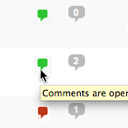前言介紹
- 這款 WordPress 外掛「Recent Love – A List of Recent Comments」是 2007-09-13 上架。
- 目前有 20 個安裝啟用數。
- 上一次更新是 2010-03-28,距離現在已有 5516 天。超過一年沒更新,安裝要確認版本是否可用。以及後續維護問題!
- 外掛最低要求 WordPress 1.5 以上版本才可以安裝。
- 尚未有人給過這款外掛評分。
- 還沒有人在論壇上發問,可能目前使用數不多,還沒有什麼大問題。
外掛協作開發者
ronr |
外掛標籤
內容簡介
顯示你的讀者最近的評論列表(通常在側邊欄中)。 預設情況下,顯示最近五個已評論文章的最新評論。
您可以控制:
要顯示多少最近的評論
要顯示文章標題的多少個字符
如何在列表中樣式化每個評論(使用開/關標籤)
是否包括或省略引用的迴響
是否包括或省略文章作者的評論
希望永遠不顯示評論的使用者列表(例如您自己;或使用此選項創建黑名單)。
輕鬆設置說明請參閱「安裝」。
歷史
幾個月前,我想在我的博客的側邊欄中顯示最近評論的列表。 在搜尋無數返回評論列表的插件後,我最終決定使用Scott Reilly的Top/Recent Commenters插件。
不幸的是,我必須調整Scott的代碼才能按照我的意願工作。一個調整引導到另一個(您知道它是如何運作的),直到我最終放棄了原始代碼並自己推出了插件。(您可以在我的博客的主頁看到它在運行。)。
功能
添加單個模板函數:
rr_recent_comments (
$num_recent_posts = 5,
$before = '
$after = '
)
函數 rr_recent_comments()返回最新評論的列表。
當無參數調用時,它返回包含最近5篇文章的最新評論的列表。 列出每篇文章僅有一個評論(最新的評論)。
默認情況下,不會包括任何由文章作者進行的評論。(此行為可以根據設定進行修改)。 過長的文章標題會根據您的設定進行截斷。默認情況下,不包括迴響和引用的迴響在列表中。
基於各種標準(作者電子郵件,作者姓名等),您可以排除特定的貼文者。 例如,排除自己的查看十分有用。
您可以通過標籤參數和全局配置選項對列表進行自定義設置。
參數
函數 rr_recent_comments()具有三個參數,所有這些參數都是可選的。
$num_recent_posts
要顯示的评论數[最大]。
默認值:5
$before
每個評論前顯示的文本。
默認值: ‘
$after
每個評論後顯示的文本。
默認值:‘
配置選項
可以通過編輯插件文件rr_recent_comments.php中的一些值來全局自定義 rr_recent_comments()的行為。
除了$max_title_length之外,大多數安裝可能都不需要調整這些值,但如果您需要,可以使用它們。
$max_title_length(默認值:38)
此值表示未經截斷即可顯示的文章標題的最大長度。 長度超過此值的標題將被不加區分地截斷。
原文外掛簡介
Displays a list (typically, in your sidebar) of your visitors’ recent comments.
By default, shows the latest comment from each of the last five commented-on posts.
You control:
how many recent comments to display
how many characters of the post title to display
how to style each comment in the list (with open/close tags)
whether to include or omit trackbacks/pingbacks
whether to include or omit comments from the post’s author
a list of users for whom never to display comments (e.g., yourself; or use this to create a blacklist).
See “Installation” for easy setup instructions.
History
A few months ago, I wanted to display a list of recent comments in my blog’s
sidebar. After searching through the countless plugins which return lists of
comments, I finally decided on Scott Reilly’s Top/Recent
Commenters plug-in.
Unfortunately, I had to tweak Scott’s code to get it to work the way I wanted.
One tweak led to another (you know how it is) until I finally just scrapped
the original code and rolled my own. (You can see it in action on my blog’s
front page.)
What It Does
Adds a single template function:
rr_recent_comments (
$num_recent_posts = 5,
$before = '
$after = '
'
)
The function rr_recent_comments() returns a list of recent comments.
When invoked with no parameters, it returns a list containing the latest comment from
each of the most recent 5 posts. Only one comment (the most recent one) per
post is listed.
By default, any comments made by the author of the post are not
included in the list. (This behaviour can be configurably modified.) Long
post titles are truncated to a length which you can configure. Trackbacks and
pingbacks are not included in the list by default.
You can exlcude certain posters, based on various criteria (author email,
author name, etc.). This is helpful, for example, to exclude yourself from
the list.
You can customize your list two ways: tag parameters and global config
options.
Parameters
The function rr_recent_comments() takes three parameters, all of which are optional.
$num_recent_posts
The [maximum] number of comments to display.
Default: 5
$before
The text to display before each comment.
Default: ‘
$after
The text to display after each comment.
Default: ‘
’
Configuration Options
The behaviour of rr_recent_comments() can be customized on a
global basis by editing some values in the plugin file, rr_recent_comments.php.
With the possible exception of $max_title_length,
most installations will probably not need to
futz with these, but they’re there if you want ’em.
$max_title_length (Default: 38)
This value represents the longest length that a post title
may be without it being truncated for display. Titles longer than this will
be indiscriminately chopped, and an ellipses will be appended to them. Set to
0 to disable truncation altogether (not recommended).
$exclude_authors_comments (Default: true)
Set to true to exclude an author’s comments from his/her
own posts. Set to false to include them.
$link_to_commenters_websites (Default: true)
Set to true to hyperlink the comment author’s name to the
website they enter on your comment form. Set to false to suppress
hyperlinking.
$suppress_trackbacks (Default: true)
If true, trackbacks and pingbacks are excluded from the
comment list. Set to false to include them.
$identify_authors_by and $excludes_sql_list
(Default: no exclusions)
These two fields work in conjunction to allow you to
specify a list of comments whose comments should never be included in
the list. (Note that most blog installation will not need to use this
functionality.)
First, choose the criterion by which you want to identify the
excluded comments and set $identify_authors_by to one of:
'comment_author',
'comment_author_url' or
'comment_author_email'.
Then add the excluded commenters to the list $excludes_sql_list;
be careful to follow the correct format, which is: ('COMMENTER_1', 'COMMENTER_2', ..., 'COMMENTER_N').
You must specify the COMMENTERs in a way that matches the value of $identify_authors_by. I.e., if $identify_authors_by
is 'comment_author_email', then the COMMENTERs in $excludes_sql_list must all be email addresses.
Revision History
0.1 (May 1, 2005): Initial revision.
0.2 (October 30, 2005): Rewrite and add new features.
0.3 (November 11, 2005): Clean up for publication.
0.4 (?)
0.5 (April 4, 2007): Add $link_to_commenters_websites option.
各版本下載點
- 方法一:點下方版本號的連結下載 ZIP 檔案後,登入網站後台左側選單「外掛」的「安裝外掛」,然後選擇上方的「上傳外掛」,把下載回去的 ZIP 外掛打包檔案上傳上去安裝與啟用。
- 方法二:透過「安裝外掛」的畫面右方搜尋功能,搜尋外掛名稱「Recent Love – A List of Recent Comments」來進行安裝。
(建議使用方法二,確保安裝的版本符合當前運作的 WordPress 環境。
延伸相關外掛(你可能也想知道)
 Akismet Anti-spam: Spam Protection 》Akismet會檢查您的評論和聯繫表單提交,將它們與全球垃圾郵件數據庫進行比對,以防止站點發佈惡意內容。您可以在部落格的“評論”管理畫面中檢查評論垃圾郵件的...。
Akismet Anti-spam: Spam Protection 》Akismet會檢查您的評論和聯繫表單提交,將它們與全球垃圾郵件數據庫進行比對,以防止站點發佈惡意內容。您可以在部落格的“評論”管理畫面中檢查評論垃圾郵件的...。 Antispam Bee 》用 Antispam Bee 保障你的 WordPress 博客或網站免受評論垃圾郵件的困擾。這個外掛可以有效地阻止垃圾評論和引用,不需要驗證碼,也不會將個人信息發送給第三...。
Antispam Bee 》用 Antispam Bee 保障你的 WordPress 博客或網站免受評論垃圾郵件的困擾。這個外掛可以有效地阻止垃圾評論和引用,不需要驗證碼,也不會將個人信息發送給第三...。 Spam protection, Anti-Spam, FireWall by CleanTalk 》Forms spam filter, Plugin extends spam protection for Gravity Forms. It filters spam submissions for each form created with Gravity Forms., MemberP...。
Spam protection, Anti-Spam, FireWall by CleanTalk 》Forms spam filter, Plugin extends spam protection for Gravity Forms. It filters spam submissions for each form created with Gravity Forms., MemberP...。 Disable Comments 》Disable Comments Plugin 是一個供管理員完全關閉網站評論功能的工具。我們的外掛程式可以全域性地關閉所有文章、頁面和附件的評論功能,移除所有相關的功能...。
Disable Comments 》Disable Comments Plugin 是一個供管理員完全關閉網站評論功能的工具。我們的外掛程式可以全域性地關閉所有文章、頁面和附件的評論功能,移除所有相關的功能...。 Comments – wpDiscuz 》wpDiscuz是一個具有自訂評論表單和欄位的AJAX即時評論系統,旨在加強WordPress原生評論功能。速度超快且具有數十種功能,是Disqus和Jetpack Comments的最佳替...。
Comments – wpDiscuz 》wpDiscuz是一個具有自訂評論表單和欄位的AJAX即時評論系統,旨在加強WordPress原生評論功能。速度超快且具有數十種功能,是Disqus和Jetpack Comments的最佳替...。Disqus Comment System 》Disqus 是網路上最受歡迎的評論系統,被數百萬的出版商信任,以增加讀者參與度、成長觀眾及流量、以及賺取內容。Disqus 協助各種尺寸的出版商直接與其觀眾互...。
Cookies for Comments 》這個外掛將會在你的部落格 HTML 的原始碼中新增一個樣式表或圖片。當瀏覽器讀取該樣式表或圖片時,會放置一個 Cookie。如果有使用者在這之後留下評論,該 Coo...。
Throws SPAM Away 》這個外掛的開發旨在打擊海外的評論垃圾郵件,目前以下的篩選器被用來判定垃圾郵件。, ・日語篩選(是否包含日語), 只有留言中包含日語字符才能被發布,沒...。
Subscribe to Comments 》Subscribe to Comments是一個強大的 WordPress 外掛,讓留言者可以訂閱文章回覆的電子郵件通知。此外掛還包括一個完整的訂閱管理工具,使留言者可以取消訂閱...。
 Disable Comments 》此外掛完全禁用網站前端和後端的評論功能:, * 隱藏現有評論, * 在前端關閉評論, * 禁用評論、引用通告和Ping的支援, * 重新導向任何試圖訪問評論頁面的使用...。
Disable Comments 》此外掛完全禁用網站前端和後端的評論功能:, * 隱藏現有評論, * 在前端關閉評論, * 禁用評論、引用通告和Ping的支援, * 重新導向任何試圖訪問評論頁面的使用...。 WordPress Native PHP Sessions 》 , WordPress 核心不使用 PHP sessions,但有時您的使用案例、外掛或佈景主題可能需要使用它們。, 此外掛實現了 PHP 的原生 session handlers,後台由 WordPr...。
WordPress Native PHP Sessions 》 , WordPress 核心不使用 PHP sessions,但有時您的使用案例、外掛或佈景主題可能需要使用它們。, 此外掛實現了 PHP 的原生 session handlers,後台由 WordPr...。 Subscribe To Comments Reloaded 》Subscribe to Comments Reloaded 是一個功能強大的外掛,讓留言者可以訂閱後續評論的電子郵件通知。此外掛還包括一個完整的訂閱管理器,讓留言者可以取消訂閱...。
Subscribe To Comments Reloaded 》Subscribe to Comments Reloaded 是一個功能強大的外掛,讓留言者可以訂閱後續評論的電子郵件通知。此外掛還包括一個完整的訂閱管理器,讓留言者可以取消訂閱...。Post-Plugin Library 》Post-Plugin Library 是一個共享代碼庫,並沒有獨立的功能,必須安裝它才能為 Similar Posts、Recent Posts、Random Posts、Popular Posts 和 Recent Comment...。
 One Click Close Comments 》使用者可以從文章管理頁面(‘編輯文章’)及頁面管理頁面(‘編輯頁面’)中,對於他們有足夠權限進行更改的文章關閉或開啟評論(基本上是管...。
One Click Close Comments 》使用者可以從文章管理頁面(‘編輯文章’)及頁面管理頁面(‘編輯頁面’)中,對於他們有足夠權限進行更改的文章關閉或開啟評論(基本上是管...。 No Page Comment 》直到最近,WordPress 提供兩種選擇:你可以默認禁用所有頁面和文章的評論和引用追蹤,或者你可以啟用它們。在WordPress 4.3 版本中,這種情況終於改變,所以...。
No Page Comment 》直到最近,WordPress 提供兩種選擇:你可以默認禁用所有頁面和文章的評論和引用追蹤,或者你可以啟用它們。在WordPress 4.3 版本中,這種情況終於改變,所以...。
